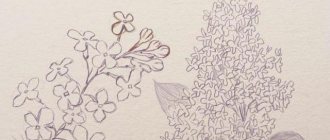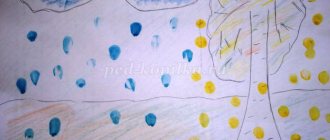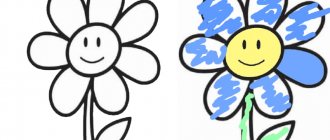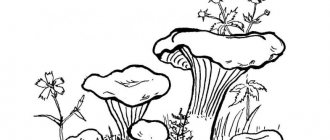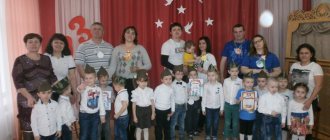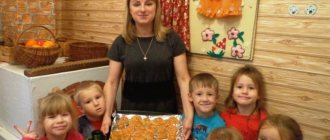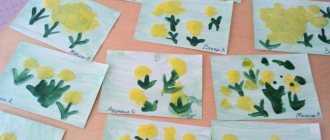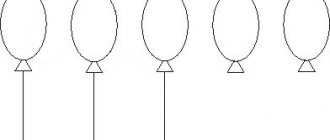Progress of the lesson:
I. Organizational moment
Hello guys! (An audio recording of the sound of rain is heard.)
Children, listen, what do you think this sound is like? (To the sound of rain). What is this rain? (Water drops).
Setting the goal of the lesson:
Guys, let's draw raindrops with water. Please come to my table. (Children approach the demonstration table).
II. Creative and exploratory work of children
Guys, please guess the riddle:
Riddle about the cloud
Sacks with holes in them run like a crowd across the sky, and sometimes water flows from the bags. Let's hide better From the leaky one. (clouds)
That's right, it's a cloud. Look how I draw a cloud with wax crayons.
(The teacher demonstrates the technique of drawing clouds with wax crayons. While drawing, the teacher talks with the children about clouds and clouds).
What color are clouds? (Black, blue, and the clouds are white). What falls from the cloud to the ground? (Rain, hail, snow). Where can it rain? (On the street).
It's going to rain from my cloud now. I'll paint it with water. Look what's in the glass? (Water). What color is the water? (Transparent). Do you think it is possible to paint raindrops with clear water? (No). Why? (The droplet will not be visible). So, what do we need to do with the water to make it visible? (Paint the water with paint). Well done, you guessed it.
(The teacher invites one of the children to paint over the water in a glass with a brush with gouache).
What color is the water in the glass? (Children name the color of the water in the glass. The color can be different, at the child’s discretion, since the palette contains gouache of different colors).
Look what I have in my hands? (Shows a pipette). That's right, a pipette. We will draw raindrops with an eyedropper.
Clarification of safety rules:
Look, the pipette is made of glass. Can you put glass in your mouth? (No). Throw the pipette on the floor? (No). Why? (It may break and you can cut yourself with glass shards).
Watch how I draw rain with an eyedropper.
(The teacher demonstrates how to draw rain with water from a pipette. During the show, she tells and shows how to draw water into a pipette and distribute droplets of water over the entire surface of the album sheet).
Now, guys, let's prepare our fingers for drawing.
Finger gymnastics “Rain”
Rain, rain, drop, Water saber, I cut the puddle, I cut the puddle, I cut, I cut, I didn’t cut, And I got tired and stopped. (I. Tokmakova)
(Children rhythmically tap the palm of their other hand with their index finger, gradually slowing down the pace, according to the text of the poem).
Guys, close your eyes, listen to the sound of the rain and think what color your rain will be. (An audio recording of the sound of rain is heard.)
Have you thought about it? Now sit down at your desks and get to work.
(Children work independently. Individual help from a teacher as needed. While children work, an audio recording of the sound of rain is played).
Smart girls. Now the rain has stopped. In the meantime, while the raindrops are drying from your clouds, come out to me and let’s play a game.
Dynamic game "Rain"
Rain, rain, rain and rain. (Children show raindrops on their palms with their fingers)
Don't be sorry for the wet drops. We clap our hands (Perform movements according to the text of the poem)
We stomp our feet. The sun is out again and the children are all going for a walk. (Perform movements according to the text of the poem)
(An audio recording of the sounds of rain is played, children run away under the teacher’s umbrella).
III. Lesson summary
The game is over and your raindrops have dried up. Please take your works and bring them to my table.
What a fabulous, unusual rain you made! (The teacher and the children look at the drawings and discuss the color of the rain). Guys, what did you draw? What did you use to draw raindrops? Did you like the lesson?
As a keepsake of our lesson, I give you balloons. They are blue and look like raindrops.
In 1930, the film “The Rogue Song” about the kidnapping of a girl in the Caucasus Mountains was released in America. Actors Stan Laurel, Lawrence Tibbett and Oliver Hardy played local crooks in this film. Surprisingly, these actors are very similar to the heroes.
Summary of a drawing lesson in the middle group “Draw a picture about summer rain”
Alina Budylskaya
Summary of a drawing lesson in the middle group “Draw a picture about summer rain”
“Draw a picture about summer rain”
Goal: - to teach children to reflect their impressions ways
- consolidate the techniques of drawing with wax crayons , painting with a brush , the ability to hold a brush correctly, and rinse it in water;
- encourage drawing of different objects in accordance with the content of the drawing;
- to arouse in children an interest in nature, the ability to see its beauty.
Materials: album sheets, wax crayons, paints, brushes, cups of water, napkin.
Summary of educational activities in drawing for the middle group “Rain, rain, drop”
Svetlana Azyrkina
Summary of educational activities in drawing for the middle group “Rain, rain, drop”
Teach children to create an image of rain drawing method (using pipettes)
.
Educational: evoke an emotional response, cultivate a sensitive and caring attitude towards nature and the beauty of the surrounding world.
Educational: learn to draw rain with a pipette , evenly distributing drops of water over the surface of a landscape sheet. Continue to teach how to convey simple phenomena of reality in drawing. Learn to combine actions with the words of a poem.
Developmental: develop imagination , fine motor skills, aesthetic attitude to the surrounding world.
White album sheet, plastic glasses with water. Palette with paints, brushes, wet wipes. Brush holders, easel, umbrella.
Verbal, practical, visual.
Drawing with plasticine and fingers. Reading nursery rhymes and poems about rain .
Lesson notes for the middle group “Autumn Tree”
Lesson summary middle group
Subject:
Autumn tree.
Target:
Formation of skills in the ability to draw thick and thin branches using a thin brush and gouache.
Tasks:
artistic and aesthetic development:
- continue to teach children to draw a tree, conveying its characteristic features: the trunk, long and short branches diverging from it;
— consolidate the techniques of painting with a brush, the ability to hold a brush correctly, and rinse it in water;
- consolidate gouache painting techniques
Methods and techniques:
Visual method: showing pictures on the theme “Autumn in the Forest”, looking at the pictures.
Verbal method
: conversation on the topic “What happens in nature in autumn.”
Practical method
: d/i ""Find the error";
Equipment:
for the teacher: Pictures “Autumn in the forest”, gouache, brush, glass of water, sheet of paper.
for children: a sheet of paper, gouache, a glass of water, a brush.
Content:
- Introductory part.
— Guys, what time of year do you think it is ? (Autumn).
— Autumn lasts three months. Let's call the autumn months. ( September October November
) What happens in the fall in the forest, in the park, etc. ?
— What color are the leaves on the trees? (Yellow, green, orange, etc.)
In autumn it gets a little colder, but still warm. The sun shines brightly. It's raining. The leaves on the trees begin to change color. Vegetables and fruits are harvested in gardens and fields. Mushrooms are collected in the forest. Migratory birds gather in flocks and prepare to fly south.
- Look at the beautiful pictures we have on the board. Where do you think autumn has come here? (To the forest, to the park.)
That's right, how did you guess?
(Children's answers.)
Look how beautiful the trees are in the fall. Let's draw an autumn tree too.
- Main part.
- Where do you think we will start drawing a tree? (From the trunk.)
That's right, first we will draw a trunk, whoever wants which one, you can get a thick trunk like an oak or a smaller one.
We take a brush, let's show how we hold the brush correctly. (Children show the teacher.)
Well done, remember.
What color of gouache will we use for the trunk? (Brown.)
That's right, we first dip the brush in water and then in gouache.
Now we put brown gouache on a brush, and then draw the trunk. I draw an even, straight line from bottom to top. The tree has a straight, beautiful, even trunk. With the tip of the brush I paint 2 small branches on the tops of the heads, which look up at the sun. The tree has thick branches, and they all grow upward - towards the sun, I paint them with the whole brush on one side and the other of the trunk. And on thick branches there are thin ones, they also reach out to the sun, I paint them with the tip of a brush on one and the other side of the branch. Then we will draw the leaves, what color will they be? (red, yellow, green, orange.)
That's right, we will have them in different colors, as in the picture. Rinse the brush in water. We will draw the leaves by “dipping” the brush to a sheet of paper. I put water on my brush and paint on yellow gouache. I paint leaves on tree branches quickly, applying and lifting the brush from the paper. Like this. I painted the leaves with yellow color, then I rinsed the brush well with water and applied red gouache, as well as orange color.
Finger gymnastics.
“Collecting leaves”
One, two, three, four, five, (we bend our fingers, starting with the thumb)
We will collect leaves. (clench and unclench your fists)
Birch leaves (bend your fingers, starting with the thumb)
Rowan leaves
poplar leaves,
Aspen leaves,
We will collect oak leaves,
We'll take an autumn bouquet to mom. (“walk” on the table with the middle and index fingers)
Independent activity of children, the teacher helps.
3.Final part.
- Let's attach our drawings to the board. Look, we have a whole forest. What beautiful trees you and I have turned out to be.
— What colors do we have in the pictures?
How to write a summary of visual arts
The drawing notes in the senior group are written according to the following plan.
- Topic of the lesson.
Usually taken from the program. - Target
. Three to five tasks for this lesson are prescribed, which involve acquiring new knowledge and consolidating existing skills. - Material
. The instrumentation is indicated, right down to the last brush. What techniques will be used, what equipment will be needed. - Progress of the lesson.
The theoretical part begins with preliminary work on the topic. So, a fairy-tale character may come to visit, who needs to be drawn or who needs help to portray something. With the help of poems, stories, looking at paintings, and visual material, the necessary properties of the object that needs to be drawn are revealed. Then, in practice, children complete the task, and at the end of the lesson, conclusions are drawn about the knowledge gained.
Nowadays, in kindergartens, classes are called “direct educational activities” (DEA). Drawing in the older group did not change its essence. Didactic games, game techniques, and various techniques are also used to make children want to draw the desired object or phenomenon.
Irina Zamyatina
"It's raining". Summary of a lesson in artistic creativity (drawing) in the senior group
Topic: " It's raining"
»
Educational field: " Artistically"
- aesthetic development"
Goal: To develop children’s ability to figuratively reflect impressions of the life around them in drawings.
Objectives: Strengthen the ability to build a composition of a drawing. Develop the ability to use acquired techniques to convey phenomena in drawing. Practice drawing
a simple graphite pencil, colored pencils or colored wax crayons.
Types of integration areas: “ Artistic creativity
"
, "Music"
,
"Cognition"
,
"Socialization"
,
"Communication"
.
Materials and equipment: Graphite pencil, colored pencils or wax crayons, sheet A-4 (for each child)
.
Notes on drawing in the middle group Topic: “Rain, rain, drop”
Compiled by Elena Viktorovna Kiseleva, teacher of the first qualified category
Drawing notes
Subject:
"Rain, rain, drop"
Target
: developing children’s skills to create an image of rain using an unconventional drawing method (using pipettes).
Tasks:
Educational:
introduce the technique of drawing rain with a pipette, evenly distributing drops of water over the surface of a landscape sheet. Continue to teach how to convey simple phenomena of reality in drawing. Learn to combine actions with the words of a poem.
Developmental:
promote the development of imagination, fine motor skills, and an aesthetic attitude towards the surrounding world.
Educational:
to cultivate a sensitive and caring attitude towards nature and the beauty of the surrounding world, to evoke an emotional response.
Materials: white album sheet, wax crayons, plastic glasses with water.
Palette with paints, brushes, wet wipes. Brush holders, easel, umbrella. Motivation
B :
Hello guys! (An audio recording of the sound of rain is heard.)
Children, listen, what do you think this sound is like? (To the sound of rain). What is this rain? (Water drops).
Guys, let's try to draw raindrops with water. Please come to my table.
Communication, listening to music.
Updating of reference knowledge
IN:
Guys, please guess the riddle:
Sacks with holes in them run like a crowd across the sky, and sometimes water flows from the bags. Let's hide better From the holey cloud
That's right, it's a cloud. Look how I draw a cloud with wax crayons.
(The teacher demonstrates the technique of drawing clouds with wax crayons. While drawing, the teacher talks with the children about clouds and clouds).
What color are clouds? (Black, blue, and the clouds are white). What falls from the cloud to the ground? (Rain, hail, snow). Where can it rain? (On the street).
Educator:
It's going to rain from my cloud now. I'll paint it with water. Look what's in the glass? (Water). What color is the water? (Transparent). Do you think it is possible to paint raindrops with clear water? (No). Why? (The droplet will not be visible). So, what do we need to do with the water to make it visible? (Paint the water with paint). Well done, you guessed it.
(B: invites one of the children to paint over the water in a glass with a brush and gouache).
IN:
What color is the water in the glass? (Children name the color of the water in the glass). The color may be different, at the discretion of the child, since the palette contains gouache of different colors).
Educator:
Look what I have in my hands? (Shows a pipette).
That's right, a pipette. We will draw raindrops with an eyedropper.
Clarification of safety rules:
Look, the pipette is made of glass. Can you put glass in your mouth? (No). Throw the pipette on the floor? (No). Why? (It may break and you can cut yourself with glass shards).
Educator:
Watch how I draw rain with an eyedropper.
(The teacher demonstrates how to draw rain with water from a pipette. The teacher tells and shows how to draw water into a pipette and distribute droplets of water over the entire surface of the album sheet).
Educator:
Now, guys, let's prepare our fingers for drawing.
Finger gymnastics “Rain”
Rain, rain, drop, Water saber, I cut the puddle, I cut the puddle, I cut, I cut, I didn’t cut, And I got tired and stopped.
(Children rhythmically tap the palm of their other hand with their index finger, gradually slowing down the pace, according to the text of the poem).
Formation of new knowledge
IN:
Guys, close your eyes, listen to the sound of the rain and think what color your rain will be. (An audio recording of the sound of rain is heard.)
Have you thought about it? Now sit down at your desks and get to work.
Smart girls. Now the rain has stopped. In the meantime, while the raindrops are drying from your clouds, come out to me and let’s play a game.
Dynamic game "Rain"
Rain, rain, rain and rain. (Children show raindrops on their palms with their fingers)
Don't be sorry for the wet drops. We clap our hands and stomp our feet. The sun is out again and the children are all going for a walk. (Perform movements according to the text of the poem)
(An audio recording of the sounds of rain is played, children run away under the teacher’s umbrella).
Listening to music
Motor, play
Reflection.
The game is over and your raindrops have dried up. Please take your works and bring them to my table. What a fabulous, unusual rain you made! Guys, what did you draw? What did you use to draw raindrops? Did you like the lesson?
Guys, in front of you there are red and blue circles, those who think that they have completely coped with the task take the red circle, those who needed help from the teacher take the blue circle.
As a keepsake of our lesson, I give you balloons. They are blue and look like raindrops.

